4 Grass Diseases to Expect in Ohio During Hot and Humid Summers
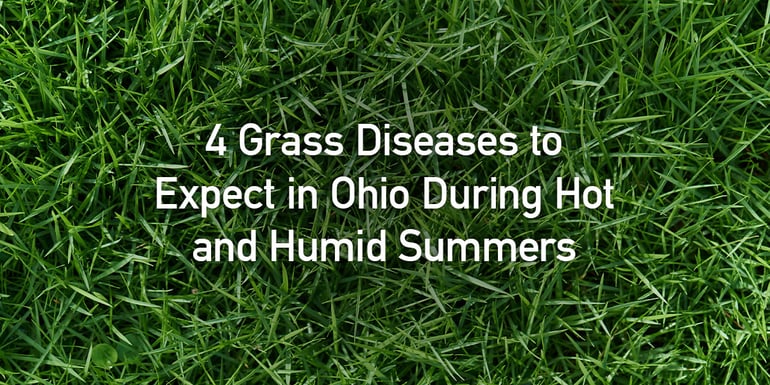
Ohio is known for its hot and humid summers, which can create ideal conditions for fungal-related grass diseases to thrive. As a result, homeowners, business owners, and landscapers alike must be aware of the various types of grass diseases that can affect lawns in Ohio during the summer months. From excess moisture to air circulation, there are several factors that can contribute to the development of grass diseases.
Learn about the four most common types of grass diseases in Ohio and how to prevent and treat them to keep your lawn healthy and vibrant throughout the season.
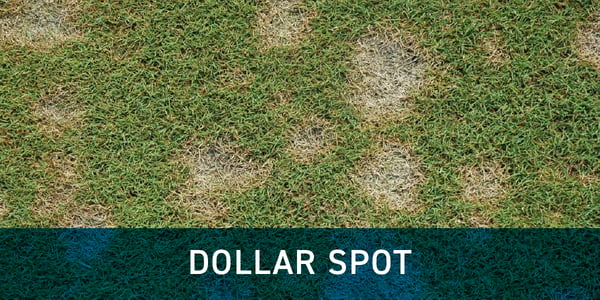
1. Dollar Spot
What is dollar spot?
Dollar spot is a common lawn disease that occurs after heavy rainfall usually during spring and early summer. The tremendous amount of rain causes excess moisture to the grass but leaves the soil dry.
What results is a fungus known as mycelium that resembles straw-like patches.
What does dollar spot look like?
Dollar spot looks like straw-colored spots about the size of a silver dollar. It can also appear in the form of a white cottony spider web in a centralized area which in actuality, is the fungus you’re seeing.
What causes dollar spot?
Turf grass that has excess moisture and dry soil simultaneously is very susceptible to dollar spot. Although it sounds unfathomable that soil can still be dry after lots of rain, it is very possible if a thick layer of thatch has formed.
Because thatch doesn’t break down as easily as grass blades, it can block air, water, and nutrients from reaching the root system. Without proper nutrition, grass becomes prone to disease and eventually stops growing.
How do you treat dollar spot?
Dollar spot can be prevented or treated with a fungicide. A Schill professional can advise whether this is a wise move.
In certain cases, once turf grass has dried out, dollar spot can go away. In any event, we strongly advise implementing a treatment program as soon as the disease is recognized.
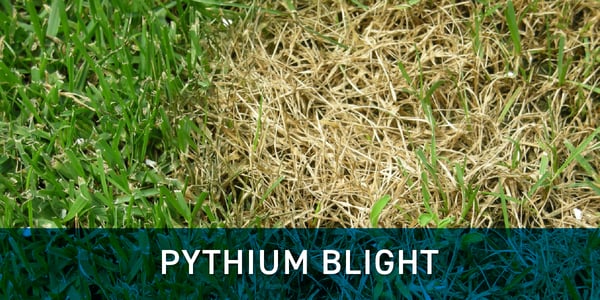
2. Pythium Blight
What is pythium blight?
Pythium blight, also known as the grease spot and cottony blight, can be a highly destructive turf grass disease. It favors hot and very humid weather and will usually develop in low areas or swales in the turf grass. Severe outbreaks can completely destroy your lawn within a few days if weather conditions favor disease development.
What does pythium blight look like?
Pythium symptoms will first appear as small, irregularly shaped spots that are ½ to 4 inches in diameter and will join to form large patches that will often be long streaks.
At first, turf grass leaves look and feel water-soaked, greasy, or slimy. Once dew or moisture dries up, the blade will shrivel up and collapse, often causing a matted brown turf.
The turf grass will develop patches that fade to a light brown or gray color. With high humidity in the early morning or throughout the day, diseased leaves may be covered with white, cobwebby, mold-like growth of the causal fungus known as mycelium.
What causes pythium blight?
Warm, humid, wet weather for prolonged periods of time causes pythium blight. Your lawn could be a target for pythium if the combined temperature and humidity exceed 150 (e.g. 90-degree weather with 65% humidity would yield a score of 150) for over 10 days. (That’s the formula we use at Schill to predict pythium onset.)
How do you treat pythium blight?
Fungicides are an effective means of treating pythium blight. Also, be sure to bag and remove lawn clippings from the infected turf since pythium fungi can stay active in plant debris and then spread to a healthy lawn.
As with other fungal lawn diseases, proper air circulation and watering is critical for treatment and prevention. Make sure the lawn is properly draining—dethatch and aerate.
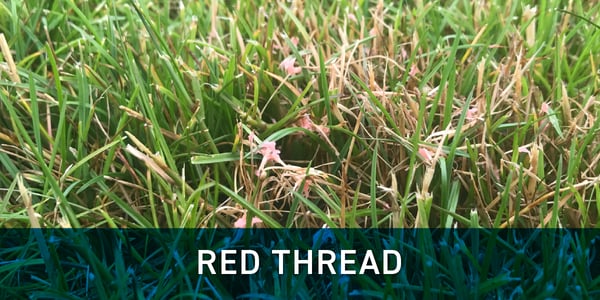
3. Red Thread
What is red thread?
Red thread is a fungal infection caused by the fungus laetisaria fuciformis. This disease causes irregularly shaped patches of tan or red throughout the lawn, specifically in the leaves and stems of the grass plant.
What does red thread look like?
Besides the pinkish-red color, lawns affected by red thread have grass blades that look ragged and seem to be dying back from the tip of the leaf.
The affected grass appears in irregularly shaped, straw-like patches that range in size from 2 inches to 3 feet in diameter.
Red thread is commonly confused with a disease called pink patch. It also has a similar appearance to pink snow mold and dollar spot, as these diseases can appear around the same time of year.
However, red thread can be identified by its antler-like structure or mycelium clusters.
What causes red thread?
Red thread is generally caused by patches of dead grass on lawns during cool temperatures (59-77 degrees) and wet conditions.
The fungus laetisaria fuciformis that causes red thread develops because of poor nutrition in turf grass, which inevitably leads to slow growth. These areas of the lawn are susceptible to red thread.
How do you treat red thread?
Just like with dollar spot, red thread can go away with proper aeration and the right nutrition program once conditions are consistently warm and dry. You can also use a fungicide on the infected area to stop it from spreading and help with growth.
As far as nutrition goes, a nitrogen-rich fertilizer will feed the soil and maintain a healthy lawn, making it more difficult for fungal diseases to infect the grass.
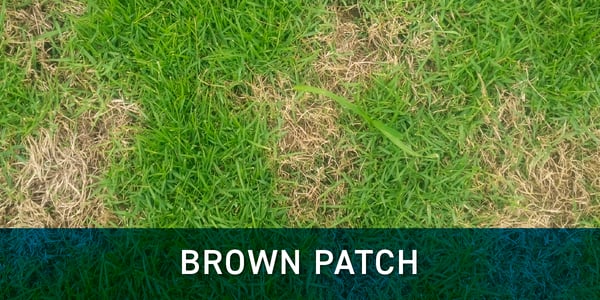
4. Brown Patch
What is brown patch?
Brown patch is another common lawn disease caused by the fungus species rhizoctonia. Brown patch is a foliar disease, meaning that it harms the blades of grass but not the crown of the plant or the root system.
What does brown patch look like?
Brown patch appears as irregular circular patches in the lawn that are brownish yellow and range from 6 inches to several feet in diameter.
The affected leaves are usually tan in color with a dark brown border and a distinctive “smoke ring” border that is sometimes visible on the outer edge, giving the patch a “frog-eye” appearance.
What causes brown patch?
Rhizoctonia is most likely to cause brown patch during periods of high temperature and humidity in mid-to-late summer when nighttime temperatures stay above 68 degrees and daytime temperatures are in the 80s or above.
Other factors that can cause brown patch are excessive nitrogen and irrigation. So, the disease is not just susceptible in poor soil, it can also affect very lush and green lawns. Other contributing factors include lack of air movement, poor soil drainage, excessive thatch, and compacted soils.
How do you treat brown patch?
Once dry weather sets in and turf airs out, brown patch can fade naturally. Proper aeration is essential to treating brown patch. It can also be treated with a fungicide, which is good as a preventative measure if your turf has had the disease before.
A certified lawn care technician will know the correct formula and application rate to ensure that you’re getting adequate coverage.
Our Team of Commercial Landscaping Specialists
At Schill Grounds Management, our team of industry specialists has expertise in treating and maintaining healthy lawns. The worst thing you can do is neglect turf care after drastic weather changes.
To learn more about our treatment programs, contact us by phone at 440-652-8031 or fill out this simple contact form and one of our client care specialists will reach out to you.
You May Also Like
These Related Stories
Turf Care: 4 Spring Grass Diseases In Northeast Ohio
3 Common Lawn Diseases In Northeast Ohio After Heavy Rainfall
4 Steps to Salvage Your Turf Before Winter Hits
Get Email Notifications
Your Trusted, Year-Round Commercial Landscaping Partner
Whether you're looking for transformative landscaping design and maintenance or reliable snow plowing and ice removal services, the Schill team is here to help

